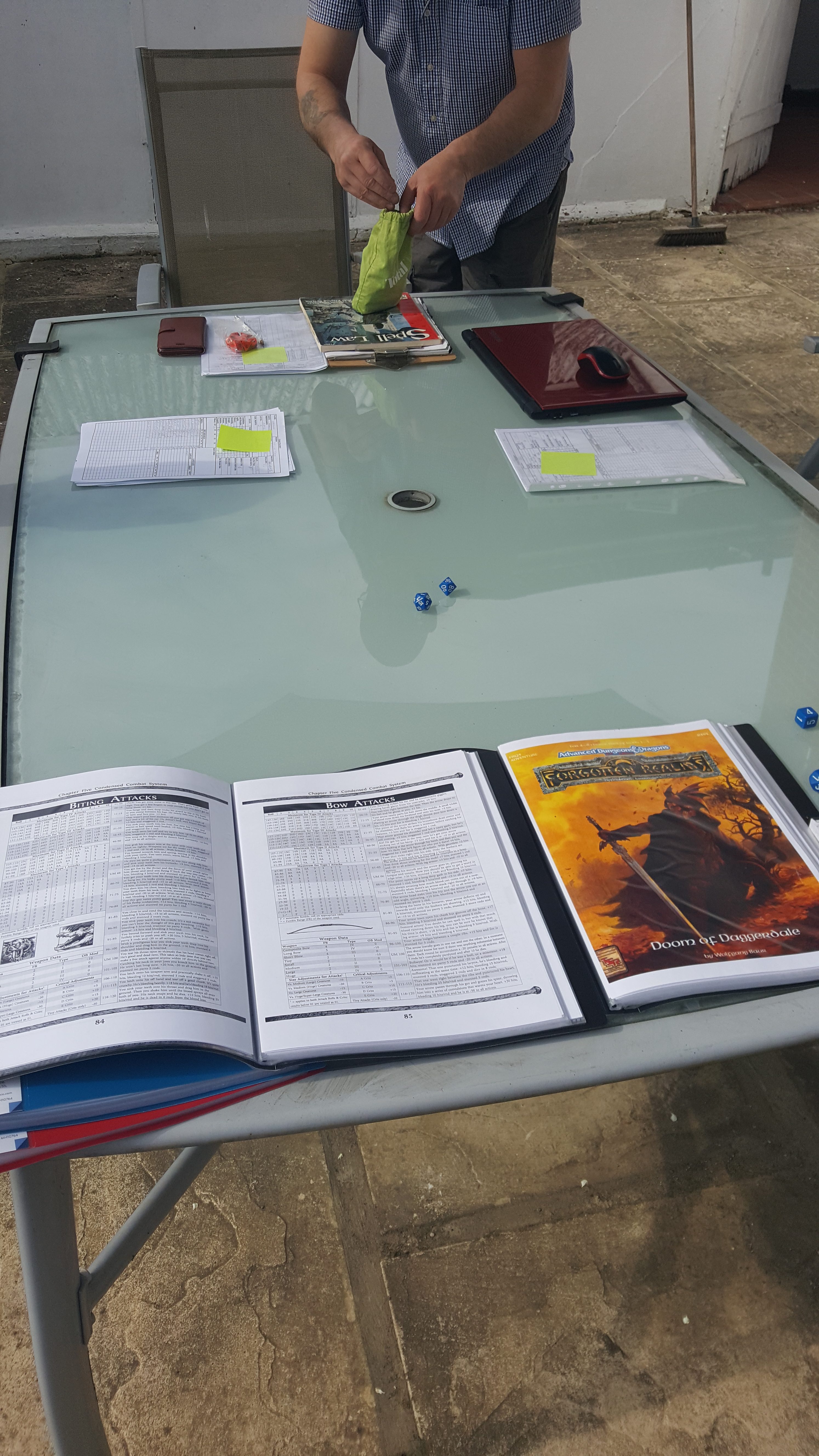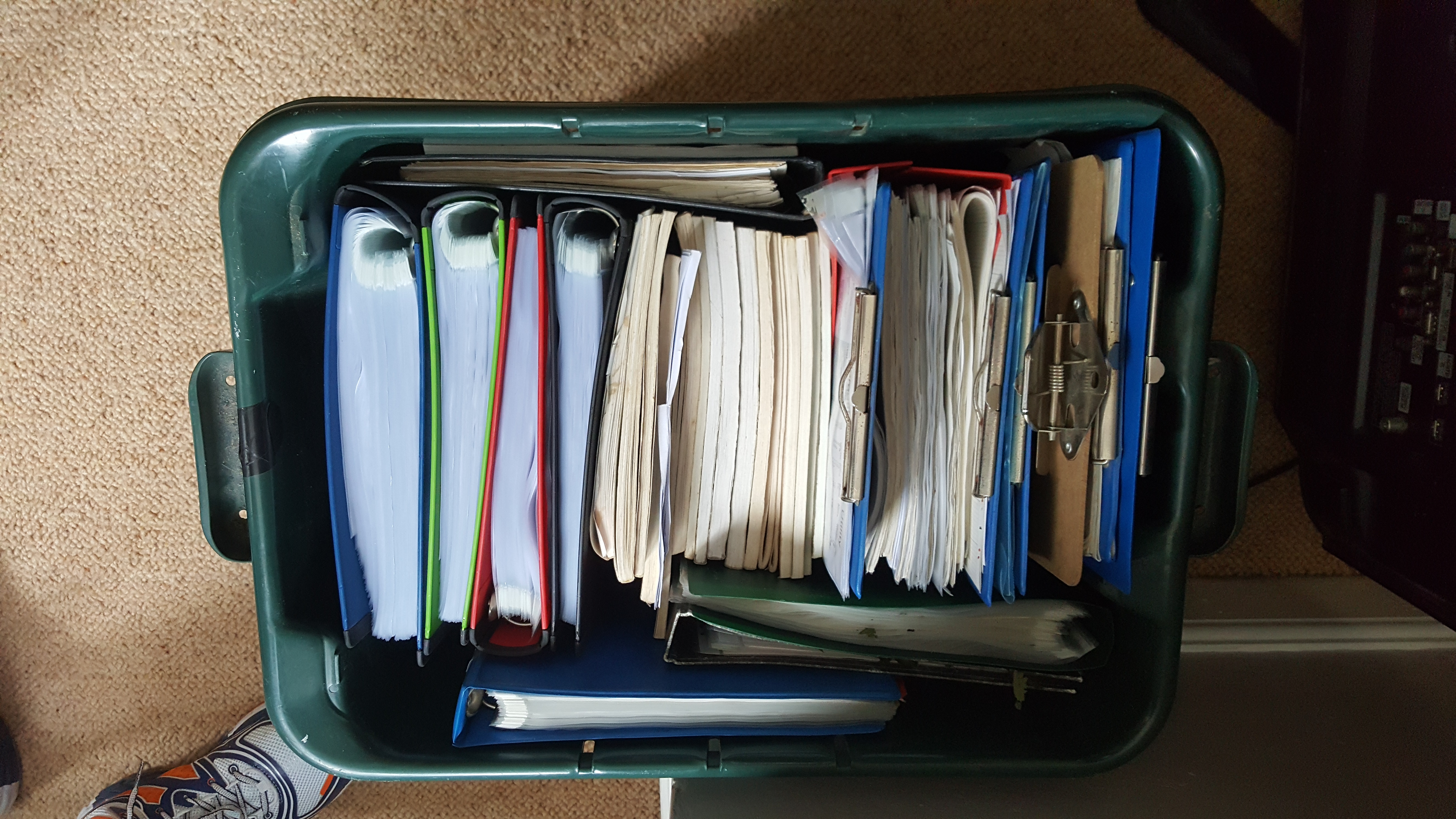I think I mentioned this before but when my group get together and game it happens two or three times a year. We rent a house, the one we have used for the past few years happens to be called Rivendell which is quite fitting, and we game all weekend. While we game we each have a sofa or armchair, when I GM I have a small side table for books and dice and it is pretty relaxed.
It sounds cool and it is but it also makes a lot of choices for us. For a start using minis is a real problem. We are all so far apart that no one would be able to see any real tactical detail we are all too lazy to get up and have a look. So that means that battle maps are out as well.
The games I was looking at last year had features like a momentum dice and counters. Well without a table to put them on these are not going to work.
Michael was the first person I saw that showcased the index card role playing game in this post. Although I really liked the concept it was going to be a non-starter for us because we are too far apart for that sort of interplay.
We are no longer the Knights of the Dinner Table, we are more like sofa sorcerers.
Being a sofa sorcerer means that you end up more organised. The rulebook you need could be right on the far side of the room and sofas are harder to get out of than dining room chairs (that sounds lame but it is true!). So when I am plotting an adventure I copy and paste the rules for specific situations right into my notes. If there is a chance of drowning then I have the drowning rules to hand. Each character has all their spells and the spell descriptions copied and attached to their character sheet, or playbook is a better phrase. So now there is no bottleneck while all the spell casters need to check which spell to cast or whether they think it will work or not. My current party has 5 PCs and they are all spell casters to a lesser or greater extent.
I don’t have a GMs screen but I have created a simple PDF of just the rules or tables I need and I keep this on a 10″ tablet. It is only about 8 pages so flicking back and forth is quick and easy. So I have pretty much ‘organised the books out of the game’. I still have them because there is nothing to stop the PCs from going completely off piste if that is how they decide to go. I certainly do not railroad my players even if I have prepared an adventure.
Because we only play a few times a year our games gravitate more towards hack and slash. This is not my first choice but with months between sessions remembering subtle clues is simply not going to happen. Unless I arrange a mystery that is all wrapped up in a weekend of gaming clue based adventures are not likely to work. You can forget political plots completely.
Another reason for not needed a GMs screen is that none of us have the eyesight anymore to read the GMs notes upside down anyway.
So are there any advantages to this laid back gaming style?
Firstly, you can game for many hours more when you are comfortable than sat on a hard dining room chair. People seem to take less breaks and we can go on for 15 to 18 hours on continuously being in character baring food breaks. The most likely cause for the session to end is when the dwarf starts snoring and even that could be in character.
When you give your players space I have noticed that the characters develop mannerism. The players start to create mannerisms, gestures and all sorts of non-verbal elements to their characters. I used to work in an office where I was the only man, my colleagues would chair dance when certain songs came on the radio. My players have started to act out their characters especially discussions within the party because they have the space to do so.
Another quirk of this style of play is that with the diminished amount of books needed we have been known to relocate outside to a garden table. You cannot see the tablet in this photo but the little pile at the end of the table is the sum total of all my campaign notes and rulebooks for the weekend.
In contrast, these are the rulebooks for a single afternoon session for a friend that GMs me occasionally.

So what is the point of this post?
I think the point is that where we each come from informs our choices and opinions. I felt I was quite down on some aspects of the games I looked at and aspects that I didn’t much like were the use of counters or visual aids like the momentum dice. You can see from this why it would not work for my hardcore laid back Rolemaster players.
It also colours my desire for rules light games. I can make just about anything rules light. Rolemaster has a reputation for being rules heavy but looking at my GM setup and you can see that it doesn’t have to be. In fact, I can run an ultralight game with all necessary rules on one piece of paper, although I do need to use both sides. That, though, is a post for another day.


Peter:
We haven’t done a marathon session in quite some time, but the last one was a hybrid. About 80% was at the gaming table: combat, travel etc but lengthy NPC interactions, expository pieces or in-game “downtime” was done in the living room. That gave everyone a break and occasionally it helped with role-playing as the players didn’t have the battle maps, dice or other docs as a distraction.
I think the relaxed atmosphere and space goes someway to promote the role playing element.
Can you tell us where this house is that you rent out. My friends and I from around the country do something similar every year and rent out a house for a long weekend. Where is this Rivendell house?
This is their AirBnB page.
https://www.airbnb.co.uk/rooms/4495259?location=Godney&checkin=&checkout=&adults=5&children=0&infants=0&guests=5&s=Wv8wiUsb
I just remembered something which you may find slightly amusing. The last time we stayed there we found a d8 in the corner of the living room where there is a small stack of board games. We play Rolemaster (D100) so it was not one that we left behind on a previous visit.
So if you do stay there you would be at the least the third party of adventurers to use the place.
The picture showing the attack tables, what book are they from ?
That is from the Combat Companion. It is, in my opinion, the best version of the Rolemaster combat system. It made 3 significant changes. Firstly, it condensed the 20 standard armour types into 10. That halved the width of the combat tables. Secondly, where Arms Law had many individual tables for the most common weapons, broad sword, scimitar etc. you also had to use a standard table plus modifiers for other common weapons, a bastard sword when used two handed was a 2H Sword -10 vs all armour types. The Combat Companion took this and created 18 pages that covered all attack types and put the modifications to differentiate each weapon or attack directly below the attack table. This meant that all the long bladed swords, broad, long, scimitar, falchion etc. were all on the same page. Then all the short blades, dagger, dirk, sai, short sword etc. were all on a second page. The third change was to customise all the criticals to the type of weapon. Normally a broadsword would do slash critical except against the heaviest armours of on the weakest attacks where you would get crush criticals, now swords do sword criticals, arrows do arrow criticals, crossbow bolts do their own and so on. These specialist critical tables sit right along side the attack table on the same page.
The result is that you can run entire combats from just a single page or maybe a pair of facing pages. The page flicking from weapon chart to critical to second weapon to different critical is almost completely eliminated.
There is only one flaw in the combat system and that is that if everyone is using similar weapons the same criticals come around too frequently. How I addressed that was to scan the most commonly used pages and reword the criticals, keeping the damage, effects and location the same. I now have a set of Saturday tables and Sunday tables. You are only talking about changing half a dozen words per critical so it was not a lot of effort but removed the single failing.
Here is an image of a single page.
http://www.rolemasterblog.com/wp-content/uploads/2015/10/bash-with-ten-at-types.png
Awesome. Thank you.